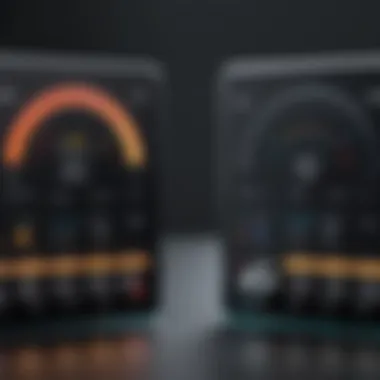Understanding Audio AD Converters: Functionality & Types


Intro
Audio analog-to-digital converters (ADCs) are critical components in the modern digital audio landscape. They bridge the gap between the analog world of sound and the digital domain where audio processing, storage, and playback occur. This intricate interplay allows for high-quality audio experiences across various platforms and devices.
As technology advances, understanding the functionality, types, and applications of audio ADCs becomes essential for tech enthusiasts and professionals alike. In this article, we'll explore the technical specifications, practical applications, and latest trends in this field, ensuring that informed decisions can be made regarding the choice and use of these devices.
Technical Specifications
When evaluating audio ADCs, technical specifications play a pivotal role in determining their performance and suitability for specific tasks. Understanding these characteristics ensures users can select devices that meet their needs effectively.
Detailed Product Specs
Audio ADCs vary widely in their specifications, which include:
- Bit Depth: This defines the number of bits used to represent audio samples, commonly ranging from 16-bit to 24-bit. A higher bit depth allows for greater dynamic range and depth in audio reproduction.
- Sample Rate: Measured in kilohertz (kHz), this indicates how often the audio signal is sampled. Common rates include 44.1 kHz, 48 kHz, and higher rates for professional audio applications.
- Dynamic Range: A crucial specification that indicates the range between the quietest and loudest sound a device can reproduce without distortion. A wider dynamic range is advantageous for capturing nuanced sound details.
- Total Harmonic Distortion (THD): This metric assesses how much distortion is introduced by the converter, expressed as a percentage. Lower THD values indicate clearer audio reproduction.
Performance Metrics
Performance metrics provide insight into how well an audio ADC functions in real-world scenarios. Key metrics include:
- Latency: The delay between the audio input and output. Lower latency is essential for live performances or real-time monitoring.
- Signal-to-Noise Ratio (SNR): This measures the level of the desired signal compared to background noise. Higher SNR values indicate clearer audio quality.
- Frequency Response: This defines how well the converter handles different frequencies. A wider frequency response ensures accurate sound reproduction across the audible spectrum.
Compatibility Information
The compatibility of audio ADCs with various devices and software is crucial for seamless integration.
- Operating Systems: Ensure the ADC works with your preferred operating systems, such as Windows, macOS, or Linux.
- Audio Interfaces: Check compatibility with different audio interfaces and DAWs (Digital Audio Workstations) for smooth workflow.
- Connectivity Options: Many modern ADCs use USB, Thunderbolt, or other proprietary connectors; verify that your setup accommodates these connections.
Finding the right audio ADC is about balancing technical specifications, performance metrics, and compatibility with your existing equipment.
Practical Applications
Audio ADCs have diverse applications, serving various groups of users. Here are a few prominent use cases:
Use Cases for Different Users
- Musicians and Producers: High-performance ADCs facilitate recording and mixing, ensuring high fidelity in music production.
- Gamers: For gamers, low-latency ADCs enhance voice recognition and game audio, providing a competitive edge.
- Podcasters and Streamers: Quality ADCs are pivotal for clear voice capture and sound quality in live streams and recordings.
Recommended Configurations
Selecting the right configuration depends on your usage:
- Home Studio: Use a 24-bit ADC with a sample rate of at least 48 kHz for music production.
- Gaming Setup: An ADC with low latency ensures real-time audio processing and communication.
Multi-Platform Performances
Many ADCs are designed for cross-platform use, providing versatile functionality across different devices:
- PCs: Compatible with various audio software and interfaces.
- Mobile Devices: Some models connect easily to smartphones and tablets for on-the-go recording.
Latest Trends
As the digital audio world evolves, certain trends are driving change in audio ADC technology.
Industry Developments
New advancements in chip design and manufacturing processes are enhancing audio fidelity and performance.
Emerging Technologies
Innovations such as AI-driven noise reduction and adaptive sampling techniques hold promise for future audio experiences.
Future Predictions
Looking ahead, we expect to see more integration of wireless technologies and smart features, improving user convenience and flexibility.
Buying Guides


Selecting the right audio ADC involves considering various factors to make informed choices.
Recommended Products
Consider devices like Focusrite Scarlett series or Zoom H series for excellent performance and value.
Purchasing Tips
- Research thoroughly: Read reviews and comparisons to assess different models.
- Consider your needs: Think about your primary usage to select the right specifications.
Warranty and Support Information
Always check warranty options and customer support services when purchasing to ensure peace of mind over your investment.
Preamble to Audio AD Converters
Definition of Audio AD Converters
Audio analog-to-digital converters (AD converters) are vital components in the digital audio ecosystem. They serve the primary function of transforming analog audio signals into a digital format that computers and other digital devices can process. In simpler terms, these devices take sound waves, which are naturally analog, and convert them into a series of numerical values representing the audio signal. This conversion is crucial for audio recording, editing, and playback as it bridges the gap between the analog world of sound and the digital environment.
Importance in Digital Audio Processing
The importance of audio AD converters in digital audio processing cannot be overstated. Their primary role is to enable the manipulation of audio signals through digital systems, which is fundamental for various applications in music production, broadcasting, and consumer electronics. Without effective conversion, the rich nuances of sound would be lost in digital processing.
Effective AD converters ensure high fidelity in audio reproduction, allowing for accurate sound capture and playback.
In addition, advancements in audio ADC technology have led to improved quality and efficiency in processing. Today’s converters offer enhanced sampling rates and bit depth, which directly impact the clarity and quality of sound. For anyone working with audio, from musicians to audio engineers, understanding the function and significance of these converters is essential. It allows users to make informed choices about their audio equipment and its capabilities.
As audio technology continues to evolve, the relevance of audio AD converters remains strong. Their integration in various devices emphasizes their role as a backbone in digital audio frameworks, ensuring both quality and accessibility of sound across platforms.
Working Principles of Audio AD Converters
Understanding the working principles of audio AD converters is essential for grasping how these devices translate analog signals into digital formats. The core functions, techniques, and processes involved directly impact audio quality and applicability across various devices and settings.
Analog Signal Processing
Analog signal processing is the entry point for all audio signals to an AD converter. It takes continuous signals from sources like microphones or instruments and prepares them for digitization. This stage helps manage noise, gain, and overall signal conditioning.
The conversion process often starts with filtering out unnecessary frequencies using analog filters. This ensures that only relevant audio signals enter the digitization process. By enhancing signal integrity, analog signal processing is crucial for achieving better overall sound quality in the final digital output.
Conversion Techniques
Different techniques are used in audio AD converters to translate analog signals into digital data. Two prominent methods are Pulse Code Modulation (PCM) and Delta-Sigma Modulation, each with its own unique characteristics and advantages.
Pulse Code Modulation (PCM)
Pulse Code Modulation (PCM) is a widely utilized technique in audio conversion. Its primary feature is the representation of an analog signal by a sequence of coded pulses. One of the key characteristics of PCM is its straightforward implementation, as it simply samples the analog signal at regular intervals.
This method is popular due to its high fidelity. Unlike other techniques, PCM avoids complex processing, making it efficient and reliable. PCM offers advantages such as a clearer representation of audio signals, which is critical in music production and broadcasting. However, the main disadvantage is that it can require a higher bandwidth for transmission, making it less ideal in specific low-bandwidth applications.
Delta-Sigma Modulation
Delta-Sigma Modulation serves as another prominent conversion technique, offering a different approach to digitizing audio signals. Its defining feature is oversampling and noise shaping, which improve the overall signal-to-noise ratio. In this method, a simple one-bit stream encodes the analog input, allowing for higher resolution in the final digital output.
One of the principal benefits of Delta-Sigma Modulation is its efficiency in achieving high-resolution audio. This makes it a favored choice in high-end audio applications. However, it can be more complex in implementation and might not be necessary for all scenarios, such as standard consumer electronics.
Quantization and Sampling
Quantization and sampling are inseparable components of the conversion process in audio AD converters. Sampling refers to the rate at which an analog signal is measured. It determines the temporal resolution of the audio. In contrast, quantization involves rounding these samples to discrete values.
Both parameters significantly influence the audio quality. For instance, higher sampling rates and greater bit depths generally yield better fidelity. However, they also demand more storage and processing capabilities. Thus, when selecting an audio AD converter, one must consider the desired output quality against practical limitations.
Types of Audio AD Converters
Understanding the types of audio AD converters is crucial for anyone working in or entering the digital audio field. Different applications require different specifications and characteristics from these converters. Choosing the right type can greatly improve audio quality and functionality while meeting specific needs. This section details various types, focusing on integrated versus standalone converters, resolution and bit depth, and sample rate variations.
Integrated vs.


Standalone Converters
Integrated converters are built into other devices, such as audio interfaces or sound cards. This can simplify setup and reduce costs. However, they often come with limitations in functionality and quality compared to standalone converters, which are specialized equipment designed solely for converting audio signals.
The integration can be very helpful for casual users who may not need high-end audio conversion. Conversely, professionals or serious audiophiles may prefer standalone models for their superior quality and flexibility. Standalone units typically allow for better performance and customization, which enthusiasts find important.
Resolution and Bit Depth
16-bit vs.
24-bit
When discussing bit depth, 16-bit and 24-bit converters are the main focus. A 16-bit converter gives you 65,536 possible levels of volume, while a 24-bit converter provides 16,777,216 levels. This difference is significant. The greater the bit depth, the more detail the converter can capture, resulting in richer sound.
Many standard consumer devices, such as some compact discs, utilize 16-bit, thus making it common yet limited in dynamic range compared to the 24-bit. For professionals, the increased detail of 24-bit becomes vital for capturing the subtleties in sound. However, the file size with 24-bit audio is larger, which could be a downside in some scenarios.
Impact on Audio Quality
The impact of bit depth on audio quality cannot be overstated. Higher bit depths reduce the noise floor, thus providing much cleaner audio. More levels allow for smoother transitions in volume levels and better capture of softer sounds. For professional applications, this is essential. The decision often hinges on whether the extra detail justifies the requirement for more storage and processing power.
Sample Rate Variations
Common Sample Rates
Sample rate defines how many samples are taken per second in audio recording. Common rates include 44.1 kHz, 48 kHz, and 96 kHz. Each of these rates is chosen based on specific needs. For instance, the 44.1 kHz rate is standard for music CDs while the 48 kHz is often used in video production.
As you increase the sample rate, the frequency response also increases. Higher sample rates lead to more accurate sound reproduction. However, higher rates require more processing power and larger file sizes. Therefore, understanding the intended application is necessary when selecting a sample rate.
High-Resolution Audio
High-resolution audio, often defined as being 96 kHz or higher, is gaining traction among audiophiles and professionals. The appeal lies in its ability to reproduce sound that is closer to the original recording. This can appeal to listeners looking for the most authentic experience, whether in music or sound design.
However, not all playback systems can handle high-resolution audio effectively. Moreover, the file sizes are much larger, necessitating more storage and bandwidth. Therefore, whether to invest in high-resolution audio capabilities will largely depend on the user's needs and the context in which the audio will be used.
Key Specifications of Audio AD Converters
When evaluating audio analog-to-digital converters, understanding key specifications is vital. These specifications can significantly impact the quality of sound and overall performance. For professionals and enthusiasts alike, knowledge of these factors is crucial in making informed decisions about equipment choices. Key specifications include dynamic range, signal-to-noise ratio (SNR), and total harmonic distortion (THD). Each of these elements plays a specific role in determining the fidelity and clarity of audio signals.
Dynamic Range
Dynamic range is the difference between the softest and loudest sounds a converter can handle effectively. It is usually measured in decibels (dB). A higher dynamic range means the device can reproduce lower sounds without distortion, increasing the overall audio quality. This aspect is particularly important in music production and high-resolution audio playback.
In practical terms, a converter with a dynamic range of 100 dB can deliver more nuanced sounds compared to one with a dynamic range of 90 dB. This range allows for a more vibrant listening experience.
The broader the dynamic range, the better the audio quality, especially in complex music tracks where volume varies significantly.
Signal-to-Noise Ratio (SNR)
The signal-to-noise ratio (SNR) measures the ratio of the desired signal to background noise. Higher SNR values indicate clearer audio signals with less interference from noise. It is also expressed in decibels. A typical SNR for high-quality AD converters ranges from 90 dB to 120 dB.
When selecting an audio converter, consider how SNR affects the listening experience. A unit with low SNR may introduce hissing or buzzing sounds, which is undesirable in high-fidelity applications. Thus, a good SNR is essential for achieving clean, accurate sound.
Total Harmonic Distortion (THD)
Total harmonic distortion quantifies how much of the audio signal is altered compared to the original input. It is usually expressed as a percentage. Lower THD percentages indicate that the converter is faithfully reproducing the input signal with minimal distortion. For instance, a THD of less than 0.1% is generally considered excellent for professional audio applications.
High THD can negatively affect sound clarity, particularly in complex audio passages. It can cause listening fatigue and an overall decrease in enjoyment. Therefore, choosing an audio converter with low THD is critical for maintaining audio integrity.
Applications of Audio AD Converters
Audio AD converters play a crucial role in various fields, enabling the conversion of analog signals into digital format. Their applications span a wide range of industries, reinforcing the significance of understanding their functions and uses. The precision of these converters is essential in maintaining audio quality and facilitating further processing. This section outlines significant areas where audio AD converters are deployed.
Music Production
In music production, audio AD converters are integral to recording, mixing, and mastering. They transform the musicians’ performances captured through microphones into a digital format. This process enables sound engineers and producers to manipulate the audio using software tools. High-quality AD converters can enhance the detail and clarity of the sound. A converter with a higher bit depth and sample rate will preserve the nuances of instruments and vocals. This quality is often noticeable in professional recordings, where each subtlety matters.
Broadcasting


Broadcasting has seen vast improvements due to audio AD converters. In radio and television, high-fidelity audio is essential for audience engagement. Converters ensure that live audio is captured and transmitted with minimal distortion. They are used in different stages, from capturing live performances to processing audio for podcasts. By converting analog signals to digital form, broadcasters can apply various effects and modifications. Thus, these converters help create a top-notch audio experience for listeners and viewers alike.
Consumer Electronics
Consumer electronics rely heavily on audio AD converters, particularly in devices like smartphones and home audio systems. These converters are essential for delivering high-quality sound to users, enhancing the overall experience. The incorporation of sophisticated AD converters in consumer devices means that everyday users can enjoy professional-level sound quality in their daily activities.
Smartphones
Smartphones have revolutionized how we consume audio. The integration of audio AD converters allows for high-quality voice calls, streaming music, and recording audio. One key characteristic of modern smartphones is their compact size without compromising audio fidelity. This creates a beneficial and popular choice for users seeking portability with quality. A unique feature is the ability to support various sound formats, which amplifies usability across applications. However, considering the limited physical space in smartphones, manufacturers must carefully balance performance and size, leading to challenges in achieving optimal audio quality.
Home Audio Systems
Home audio systems stand out for their immersive sound experience. The presence of high-caliber audio AD converters elevates the listening experience, providing fidelity that enhances music and movie soundtracks. A significant characteristic is the capability to handle high-resolution audio files, catering to audiophiles who appreciate superior sound quality. A unique feature of these systems is often the customizability and compatibility with various input sources. While home audio systems deliver exceptional sound, they may require higher investment compared to portable devices. Additionally, the setup process can be an obstacle for some users. Still, the end result is an unmatched audio experience in the comfort of one's home.
In summary, audio AD converters are pivotal in various sectors, enhancing audio quality and efficiency in music production, broadcasting, and consumer electronics. Understanding their applications is vital for anyone focusing on audio technology.
Choosing the Right Audio AD Converter
Choosing the right audio AD converter is a critical step for anyone involved in audio production or playback. The performance quality of these devices can greatly influence the listening experience, making informed decisions essential. Important factors include the specifications, use case scenarios, and the user’s skill level. This section aims to address key considerations that can guide users in selecting the appropriate converter for their needs.
Considerations for Hobbyists
For hobbyists, the journey of selecting an audio AD converter often begins with understanding personal needs. Budget plays a vital role at this stage. Many good quality yet affordable converters are available. These are ideal for beginners who want to explore audio and music production without a huge investment.
When considering features, look at sample rate and bit depth. Typically, a 24-bit depth and 96 kHz sample rate offer a good balance between quality and cost, suiting most home studios. Additionally, USB powered converters can provide convenience, avoiding the mess of power adapters.
Another factor is compatibility with DAWs (Digital Audio Workstations). Ensure the converter can work with software like Ableton Live or Pro Tools. This compatibility enables seamless integration into existing setups. Moreover, ease of use is crucial for hobbyists. Intuitive products ensure the learning curve stays manageable, allowing users to focus on creativity.
Professional Requirements
For professionals, the criteria for choosing an audio AD converter shifts toward higher standards. Professionals demand superior performance regarding dynamic range and signal-to-noise ratio. These specifications significantly impact the final audio output. A professional may consider converters that feature 24-bit depth and high sample rates like 192 kHz or more, especially in demanding environments such as recording studios or live sound settings.
Additionally, build quality and durability become paramount. Products from brands like Audio-Technica or Focusrite often gain attention due to their reputation. Features such as low latency and multiple input/output options are also critical for professionals who work with complex audio systems. Reliability is another key aspect; converters must consistently perform well under pressure.
Lastly, professionals should evaluate the mobile aspect. A compact, portable audio AD converter allows for flexibility in various settings, whether in a studio, a venue, or an outdoor event.
Remember, the right choice is based on understanding personal or professional needs, balance quality, and cost efficiency to achieve optimal audio performance.
Future Trends in Audio AD Converters
The landscape of audio analog-to-digital converters (ADCs) is poised for rapid evolution. As technology advances, so does the demand for high-quality audio representations in various applications. Understanding the future trends in audio AD converters helps both consumers and professionals make informed decisions about acquisitions and upgrades.
Technological Advancements
Recent technological innovations are driving significant changes in the audio AD converter domain. New methods of processing audio signals can lead to improved quality and efficiency. Here are some notable advancements:
- Higher Bit Depth and Sample Rates: The push for better audio quality is leading manufacturers to develop converters with greater bit depths and sample rates. This enhances dynamic range and minimizes distortion, resulting in clearer sound reproduction.
- Noise Reduction Technologies: Emerging noise reduction technologies significantly improve the signal-to-noise ratio (SNR). This is critical for professional audio production where clarity is paramount.
“Innovations in ADC technology are crucial for maintaining competitive performance in audio applications.”
- Advanced Processing Algorithms: With the integration of AI and machine learning, the precision of audio processing can change notably. These algorithms provide adaptive filtering and accurate quantization, which optimize audio fidelity.
Integration with Other Technologies
Integration with other technological realms is also shaping the future of audio AD converters. The following aspects are noteworthy:
- Smart Devices and IoT: As more smart devices enter the market, audio AD converters will be built into everyday gadgets. This integration enhances user experience by providing high-quality audio in smart speakers, headphones, and wearable technology.
- Virtual Reality (VR) and Augmented Reality (AR): The rise of immersive audio experiences in VR and AR applications underscores the need for sophisticated audio processing solutions. Future ADCs will likely support spatial audio formats to create realistic soundscapes.
- Streaming Services: With the growing popularity of high-resolution audio streaming, converters will need to adapt to support various formats and codecs, ensuring compatibility across platforms.
In summary, future trends in audio AD converters are driven by technological advancements and integration with new technologies. These developments are not only reshaping the audio production landscape but also enhancing user experiences across multiple devices.
Culmination
Understanding audio AD converters is critical in navigating the digital audio landscape. These devices have become a fundamental bridge connecting analog sound with digital technology. The efficiency and quality of sound reproduction largely depend on the specifications and features of the ADCs used.
Summary of Key Points
In our discussion of audio AD converters, several key elements emerged:
- Functionality: ADCs convert analog signals into digital format, preserving audio quality.
- Types: There are integrated and standalone converters, each serving distinct user needs.
- Specifications: Parameters such as dynamic range, signal-to-noise ratio, and total harmonic distortion determine the performance of the converters.
- Applications: These converters find use in various domains, including music production, broadcasting, and consumer electronics.
- Choosing the Right Converter: Understanding both personal and professional requirements is necessary for making informed decisions.
- Future Trends: Continuous advancements within this field will influence both technology and audio experiences.
Final Thoughts on Audio AD Converters
The realm of audio AD converters is both intricate and essential. As the demand for high-quality audio continues to rise, these devices' importance only increases. While the technical specifications may seem daunting at times, their impact on sound quality cannot be underestimated. Whether you are a hobbyist in music production or a professional in broadcasting, understanding these converters enhances your capability to make sound decisions in your audio journey. In summary, keep abreast of technological advancements and select the converters that meet your individual needs, ensuring a superior auditory experience.
The key to a successful audio experience lies not just in the device itself, but in the understanding of its role in your audio setup.







